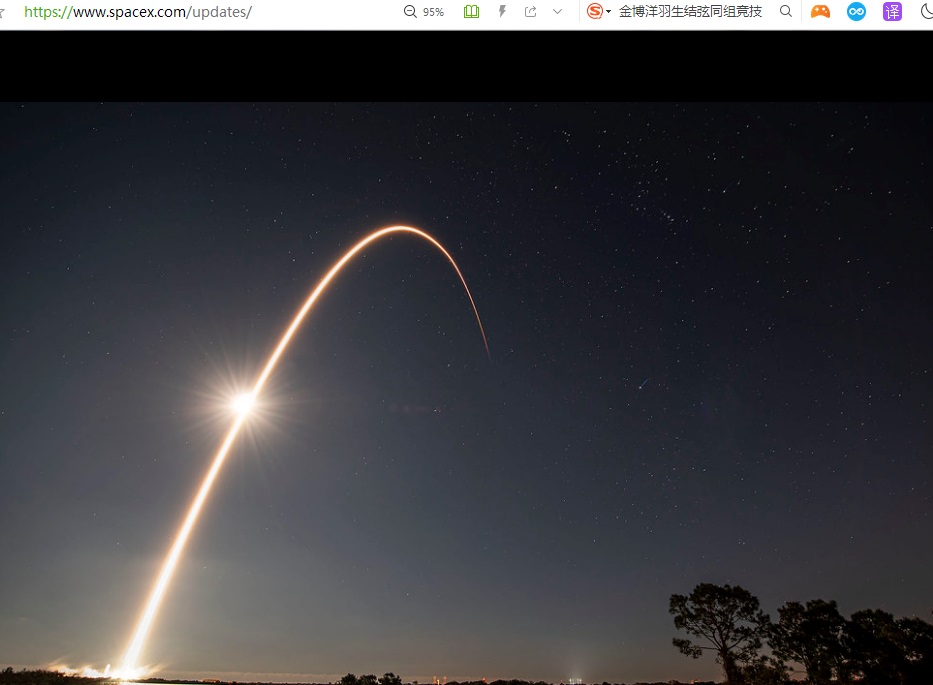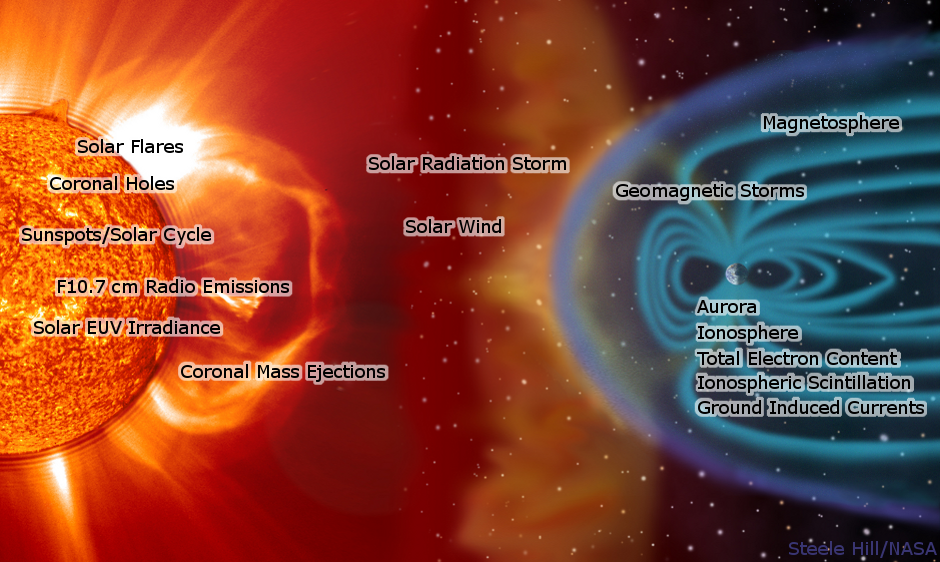周三(2022年2月3日)发射49颗星链卫星,周四(2月4日)40颗卫星受太阳磁暴影响进入大气层烧蚀损毁,预计这次发射和卫星损失高达五千万美元。
目前SpaceX已经发射1900颗星链卫星,现有14.5万个用户。
当地时间2月9日,马斯克的太空探索技术公司(SpaceX)发布官方消息称,于今年2月3日发射的49颗星链卫星中的40颗已经被一场地磁风暴给毁掉了,预估这些卫星将在不久之后重返大气层销毁,剩下的9颗又难以成组在轨组网承担信号传播任务。

马斯克的星链太空互联网卫星计划预备向地球的近地轨道发射4万颗互联网卫星,以建立覆盖整个地球的 Internet互联网络,至今已经发射了2000颗左右,今年的2月3日,SpaceX公司用猎鹰9号火箭发射了49颗Starlink组网卫星,这些卫星原计划在发射后不久就被送到了距地面210公里的低近地轨道上,在这里进行调试后,卫星将启动电推进系统上升到距地面520公里的运行轨道上,完成最终的部署,结果调试工作还没完成就遭遇到了一场大级别的地磁风暴,被摧毁了40颗卫星,这次发射算是白费了。

在较低轨道部署的星链卫星第二天受到磁暴的严重影响,导致大气变暖,大气密度增加,星载GPS显示磁暴导致大气阻力较发射前增加了50%,星链团队命令卫星进入安全模式,卫星在该模式下可以侧着飞行(fly edge-on),就像一张纸一样,这样可以最大减少阻力,有效“躲避风暴”。

初步分析显示,因大气阻力的增加阻止星链卫星离开安全模式,不能提升轨道机动,多达40颗卫星重入大气层,不会与其他卫星发生碰撞,且不会有碎片掉落地面。
当地时间2月7日凌晨2时40分左右,加勒比天文学会(SAC)的流星监控相机记录到了空间碎片再入大气层,其中的几个碎片可能是这次受磁暴影响的星链卫星有关。值得一提的是,空间碎片再入大气层的速度,比流星要慢很多,也很壮观。
地磁风暴是什么?太阳内部时刻都在进行着核聚变反应,使得其内部温度高达1,500万℃,这些能量也会向外辐射,突破太阳的表面喷发到太空中,在我们看来就是太阳表面出现了耀斑,这时候。太阳就会从耀斑处喷发出大量的太阳风,这些太阳风大部分都是由氢氦等离子体形成的,其喷射速度可达每秒500~1200公里,是空气中音速的数千倍。
当这些带电太阳风来到地球附近的时候,在大约7万公里外就会受到地球磁场磁力线的干扰,从而使得等离子太阳风沿着磁力线的方向向地球的两极靠拢,越靠近两极太阳风粒子密度越大,于是就出现了极光现象,所以从本质上来说,极光本身就是一种磁暴。
由于地球周围的卫星运行轨道的高度大都在地表以上3万公里以内,而地球磁场的有效保护范围可达地表以上7万公里,所以太阳风不会经常性地损毁太空中的卫星,但是如果太阳风足够强,地球外太空的磁力线无法完全阻挡太阳风的侵袭,那么这些带电粒子就会形成大范围的磁暴,从而影响到地球周围运行的卫星了。

磁暴现象(Magnetic Storm)
磁暴现象是指当太阳表面活动旺盛,特别是在太阳黑子极大期时,太阳表面的闪焰爆发次数也会增加,闪焰爆发时会辐射出X射线、紫外线、可见光及高能量的质子和电子束。其中的带电粒子(质子、电子)形成的电流冲击地球磁场,引发地磁扰动现象称为磁暴。
所谓强烈是相对各种地磁扰动而言。其实地面地磁场变化量较其平静值是很微小的。在中低纬度地区,地面地磁场变化量很少有超过几百纳特的(地面地磁场的宁静值在全球绝大多数地区都超过 3万纳特)。一般的磁暴都需要在地磁台用专门仪器做系统观测才能发现。
磁暴是常见现象。不发生磁暴的月份是很少的,当太阳活动增强时,可能一个月发生数次。有时一次磁暴发生27天(一个太阳自转周期)后,又有磁暴发生。这类磁暴称为重现性磁暴。重现次数一般为一、二次。
“磁暴”现象整个地球是一个大磁场,地球的周围充满了磁力线。当耀斑出现时,其附近向外发射高能粒子,带电的粒子运动时产生磁场,当它到达地球时,便扰乱原来的磁场,引起地磁的变动,一般产生在耀斑爆发后20—40小时。发生磁暴时,磁场强度变化很大,对人类活动特别是与地磁有关的工作会有很大影响。
影响地球大气太阳的远紫外线和太阳风会影响大气的密度,大气密度的变化周期为11年,显然与太阳活动有关。太阳活动还可能影响到大气温度和臭氧层,进而影响到农作物的产量和自然生态系统的平衡。
由于太阳活动对人类有影响,特别是对航天、无线电通讯、气象等方面影响显著,因此,研究太阳活动,特别是太阳耀斑发生的规律,并设法进行预报,具有重要的应用价值。
在20世纪60年代,科学家们用空间探测器证实了太阳风的存在。当太阳上面有大的爆发现象(太阳爆发、色球爆发等),特别是强烈的耀斑出现时,太阳风带电微粒急增。由于地磁场的作用,太阳风里相当一部分的带电微粒,沿着磁力线回旋在南、北磁场附近的地球高空中。
这样,处在高层大气中的各种气体原子和分子会受到带电粒子的撞击、电离和激发,从而使之产生出一种类似于充气管所出现的辉光,这便是极光现象;与此同时,在地球的磁场里往往会发生明显的磁暴现象,电讯中断了,指南针的磁针发了疯似的乱转。
A geomagnetic storm is a major disturbance of Earth's magnetosphere that occurs when there is a very efficient exchange of energy from the solar wind into the space environment surrounding Earth. These storms result from variations in the solar wind that produces major changes in the currents, plasmas, and fields in Earth’s magnetosphere. The solar wind conditions that are effective for creating geomagnetic storms are sustained (for several to many hours) periods of high-speed solar wind, and most importantly, a southward directed solar wind magnetic field (opposite the direction of Earth’s field) at the dayside of the magnetosphere. This condition is effective for transferring energy from the solar wind into Earth’s magnetosphere.
The largest storms that result from these conditions are associated with solar coronal mass ejections (CMEs) where a billion tons or so of plasma from the sun, with its embedded magnetic field, arrives at Earth. CMEs typically take several days to arrive at Earth, but have been observed, for some of the most intense storms, to arrive in as short as 18 hours. Another solar wind disturbance that creates conditions favorable to geomagnetic storms is a high-speed solar wind stream (HSS). HSSs plow into the slower solar wind in front and create co-rotating interaction regions, or CIRs. These regions are often related to geomagnetic storms that while less intense than CME storms, often can deposit more energy in Earth’s magnetosphere over a longer interval.
Storms also result in intense currents in the magnetosphere, changes in the radiation belts, and changes in the ionosphere, including heating the ionosphere and upper atmosphere region called the thermosphere. In space, a ring of westward current around Earth produces magnetic disturbances on the ground. A measure of this current, the disturbance storm time (Dst) index, has been used historically to characterize the size of a geomagnetic storm. In addition, there are currents produced in the magnetosphere that follow the magnetic field, called field-aligned currents, and these connect to intense currents in the auroral ionosphere. These auroral currents, called the auroral electrojets, also produce large magnetic disturbances. Together, all of these currents, and the magnetic deviations they produce on the ground, are used to generate a planetary geomagnetic disturbance index called Kp. This index is the basis for one of the three NOAA Space Weather Scales, the Geomagnetic Storm, or G-Scale, that is used to describe space weather that can disrupt systems on Earth.
During storms, the currents in the ionosphere, as well as the energetic particles that precipitate into the ionosphere add energy in the form of heat that can increase the density and distribution of density in the upper atmosphere, causing extra drag on satellites in low-earth orbit. The local heating also creates strong horizontal variations in the in the ionospheric density that can modify the path of radio signals and create errors in the positioning information provided by GPS. While the storms create beautiful aurora, they also can disrupt navigation systems such as the Global Navigation Satellite System (GNSS) and create harmful geomagnetic induced currents (GICs) in the power grid and pipelines.
参考资料及信息来源:SpaceX、科普大世界、BBC、CNBC。
